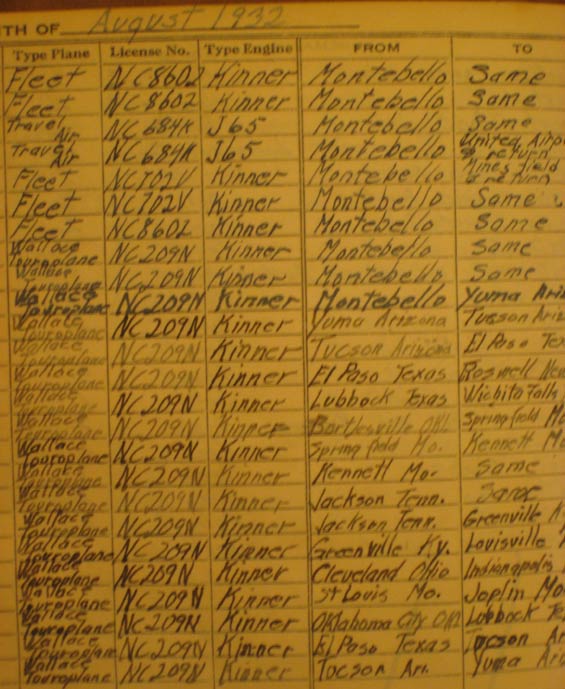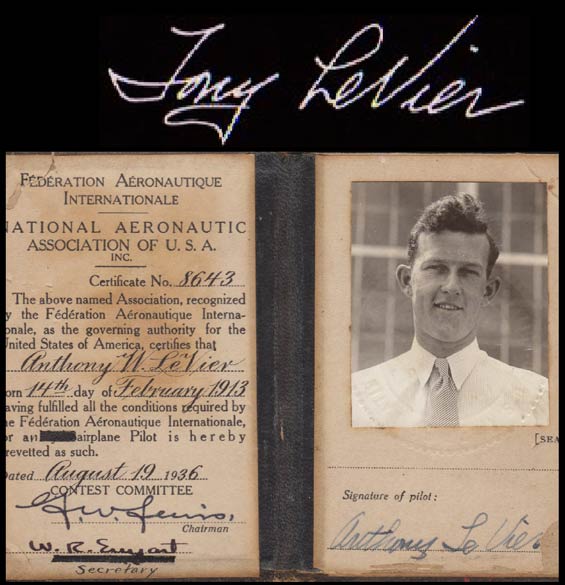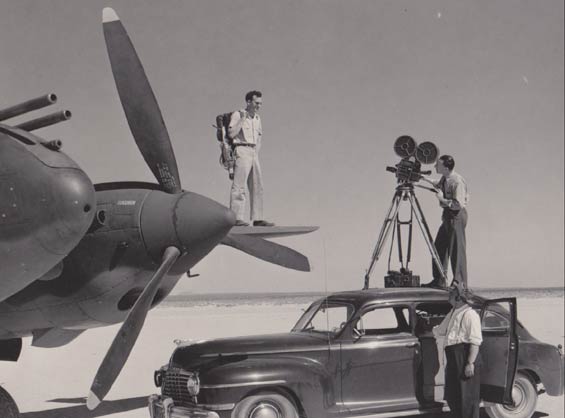Tony LeVier, ca. 1960s
(Source: NASM)
 |
Tony Levier landed at Tucson September 4, 1932 carrying
one passenger he identified as “crew”. He
was flying a Wallace aircraft, NC209N. Based in Los
Angeles, CA (he noted in the Register “east side”),
he and “crew” were westbound from El Paso, TX to Yuma, AZ, probably on their way back to Los Angeles. There
was no reason given for their flight, and LeVier emphasized
that by writing “none” in the Remarks column
of the Register. Image,
right, from the Cabot Award brochure cited in the left sidebar (from LeVier's NASM biographical file).
Born February 14, 1913 in Duluth, MN, LeVier came on the
scene at the right time to make his mark late in the Golden
Age. He
started flying in 1928 at age 15. His motivation was
Lindbergh’s
trans-Atlantic flight. When he heard
news of Lindy’s flight he announced to his mother, “I’m
going to become an airplane pilot!” His mother
said, “That’s wonderful Tony, just remember to
be a good one.” This kind of parental encouragement
echoes that of Robert Buck’s
upbringing.
LeVier did learn to fly and received his commercial license
in 1932. In 1932 the 19 year-old LeVier took second place
in the cross-country air race during America’s first
junior pilot air meet, Long Beach, CA in a Wallace Touroplane. His
stop at Tucson may have been in conjunction with that competition. Does
anyone know? You may view an image of NC209N, a Touroplane
B model with folding wings, here. Below, courtesy of his grandson (cited, right sidebar), is a page from his pilot log book for August (and probably into September), 1932. Note that he recorded landings twice at Tucson, but he recorded only one in the Register. The second landing, at the bottom of the image, is the one logged in the Register.
Tony LeVier, Pilot Log, August-September, 1932 (Source: Logan)
 |
From 1932-1939 he was a flight instructor,
charter pilot, air racer and barnstormer. Below, his FAI license for 1936, courtesy of his grandson, Bryan LeVier Logan.
LeVier's FAI License, August 19, 1936 (Source: Logan)
 |
Below, courtesy of site visitor Jeff Staines, is a U.S. Postal Service cachet dated September 5, 1937 commorating the 1937 National Air Races (NAR). It is signed by LeVier. Note in the table below that he didn't place in any of the events that year.
U.S. Postal Service cachet, NAR, September 5, 1937 (Source: Staines)
 |
In 1939 he took a job
in the experimental department of Douglas Aircraft on the
B-19 project. He flew for a year (1940) with Midcontinent
Air Line, then, as WWII approached, as test pilot with General
Motors, Laboratory Division. He became a legendary
test pilot of the WWII era.
He joined Lockheed Aircraft in 1941, beginning his career
ferrying Hudson bombers for the RAF. He joined the
Lockheed Engineering Flight Test Organization in 1942 and
was assigned to test the P-38 Lightning. He took the
P-38 through the test regimen that solved the “Mach
tuck” problem. Below, LeVier poses on the wing of a P-38 for a photo op.
Tony LeVier on Wing of P-38, Date Unknown (Source: Logan)
 |
This interesting link includes copies of 11 Lockheed company newsletters that were produced as P-38 training aids during WW II. In addition to 1940s-style sexist cartoon art, each issue includes a picture of a Lockheed test pilot in the text. Four issues include photographs of Register pilots, including LeVier, Jimmy Mattern, Milo Burcham and Joe Towle. Register pilot Elmer McLeod also worked for Lockheed during WWII.
Later,
he was assigned to England as Special Technical Representative
with Eighth Fighter Command under Lt. Gen. James Doolittle. Following is a table that summarizes his Lockheed test pilot
duties after WWII. He was appointed
Chief Engineering Test Pilot at Lockheed in 1945.
DATE |
AIRCRAFT |
ROLE |
1946 |
Saturn |
Pilot |
1946 |
Constitution |
Copilot |
1946 |
P-80R |
Pilot |
March 22, 1948 |
TF-80C Shooting Star |
Pilot |
1948-49 |
F-80, Neptune, Constellation,
etc. |
Supervisor of Testing |
June 14, 1949 |
F-90 |
Pilot |
July 1, 1949 |
F-94A Prototype |
Pilot |
January 19, 1950 |
F-94C Prototype |
Pilot |
February 28, 1954 |
XF-104 Ground Test |
Pilot |
March 5, 1954 |
XF-104 First Flight |
Pilot |
August 1955 |
U-2 Reconnaissance |
Pilot |
In 1950 LeVier was the third pilot to exceed Mach 1. He
was appointed Director of Flying Operations for Lockheed’s
California Division on May 23, 1955. He retired from
Lockheed April 29, 1974 almost 42 years after he visited
us in Tucson. In 1985 he inaugurated Safe Action in
Flight Emergency, Inc., a non-profit program dedicated to
training civilian pilots in handling life-threatening situations.
In the 1930s and into the 1940s (paralleling some of his
Lockheed duties), he entered competitions. The following
table summarizes his air race experiences.
DATE |
EVENT |
RESULTS |
1932 |
Junior Pilot Air Meet |
Second Place |
1935 |
Arizona State Air Faire |
First Place Pylon Race |
1935 |
Ontario, CA Air Faire |
First Place Pylon Race |
1938 |
Pacific Intl. Air Race |
Two Firsts & a
Third Place |
1938 |
Cleveland Air Races |
Greve Trophy |
1938 |
Thompson Trophy Race |
Second Place |
1939 |
Curtiss Cup, Miami |
Second Place |
1946 |
Thompson Trophy Race |
Second Place (P-38) |
1947 |
Thompson Trophy Race |
First Place (P-38) |
1947 |
Sohio Race |
First Place (P-38) |
1947 |
Goodyear Trophy Race |
Fourth Place |
Please direct your browser to this link for a nice summary
of air race history. At
Lockheed, LeVier crossed paths with fellow test pilot Kenneth
Hunter, another record
setter of the Davis-Monthan Airfield Register, and with Elmer McLeod.
On June 2, 1995 he received the Godfrey L. Cabot Award from
The Aero Club of New England. The award was justified. From
the Cabot Award brochure we learn that, over his career,
Tony LeVier accumulated 10,000 flight hours during 24,000
flights (some of them must have been very brief) in 260 airplane
types. As Lockheed’s Engineering Test Pilot he
made the first flights on eleven of Lockheed’s “Skunk
Works” aircraft (tabulated above).
Along the way he was involved in 101 air accidents and incidents,
including 8 crashes, 58 near crashes, 5 tailspins to “low” altitudes,
26 forced landings, 5 canopy losses, 20 pilot errors, 1 mid-air
collision and 9 near mid-air collisions. Such is the
life of an engineering test pilot.
Tony LeVier was responsible for several inventions and contributions
to airplane ergonomics and safety. For example, in
1944 he conceived the idea to turn the pilot’s stick
grip counter-clockwise in the XP-80 to enable the pilot
(who manipulated the stick with his right hand) better use
and control of the aircraft. The
same year he conceived the idea to place aircraft trim switches
on top of the control stick grip: now universally used on
all military and some civil aircraft around the world. In
1949 he conceived the first practical afterburner ignition
system for jet fighters.
He was a member of numerous aviation organizations, from
the National Aviation Hall of Fame and Society of Experimental
Text Pilots (charter member), to the I.O.C. (International
Order of Characters).
LeVier was author of numerous articles in popular and technical
publications, mostly related to safety. In 1954
he published an autobiography entitled “PILOT” in
collaboration with John Guenther. This book is easily
found for sale at numerous Web book sources. From people
I have spoken with who knew LeVier, he had a monumental ego. Not
surprising, given the work he did. Tony LeVier passed
away in California on February 6, 1998.
---o0o---
Dossier 2.1.110
UPLOADED: 06/06/07 REVISED: 10/12/07, 03/10/12
|






